
Eight charts detail the disparities in spending on men’s and women’s sports in similar major college programs.
Since the passage of the landmark Title IX law 50 years ago this summer, millions more girls and women have had an opportunity to play sports at the high school and collegiate level.
But the playing field remains uneven for many of America's top female college athletes.
Colleges and universities across the nation consistently devote fewer resources to women’s sports than men’s, according to a first-of-its-kind data analysis by USA TODAY in collaboration with the Knight-Newhouse Data project at Syracuse University.
The analysis uses revenue and expense reports that the schools submitted to the NCAA for the 2018-19 and 2019-20 fiscal years. It compares what 107 public schools in the Football Bowl Subdivision – the highest level in Division I – spent on travel, equipment and recruiting for similar men’s and women’s teams.
USA TODAY focused solely on sports in which at least 40 of the schools sponsored comparable male and female squads: basketball, baseball and softball, golf, soccer, swimming and diving, and tennis.
Here’s a graphical look at some of the findings of our analysis:
Title IX: How many more girls, women are playing sports
Enacted on June 23, 1972, Title IX prohibits sex-based discrimination by any “education program or activity receiving federal financial assistance.”
The law sparked a rapid increase in female student-athletes. The number of girls playing a high school sport alone jumped more than 600% in the first four years after the bill’s passage.
Beyond the health benefits, sports can have long-lasting positive impacts on the athletes. An ESPNW and Ernst & Young survey of 400 female corporate executives in 2015 found that 94% had played sports, and that wages for women who had played sports were 7% higher.
Despite the gains made possible by Title IX, schools are still falling short five decades later.

USA TODAY found that, for every dollar schools spent on travel, equipment and recruiting for men's teams, they shelled out just 71 cents on women. Over two seasons, that added up to $125 million more for men than women in basketball, baseball and softball, golf, soccer, swimming and diving, and tennis.
How spending differs on men’s and women’s athletic programs
The financial chasms were glaring in baseball and softball, golf and tennis. But nowhere more so than basketball, for which schools spent about $93 million more on men than women across the three expense categories.
How much the 107 schools spend on recruiting, equipment and travel across sports
Power Five conferences spend more on men’s sports, too
How some national championship-caliber women’s teams fare in spending
While most spending disparities favor men’s sports, there are instances in which schools spent more on their women’s teams, including those that won a recent NCAA title or are regularly among the championship contenders.
The North Carolina women’s soccer team – which has won 21 NCAA championships and finished as runner-up in 2018 and 2019 – received more money than its men’s team. That’s also the case with Virginia’s women’s swimming team, which recently won its second consecutive national title and finished sixth or better in three of the five previous NCAA championships.
Meanwhile, the Connecticut women’s basketball team has been behind the Huskies men’s teams in these spending areas, despite having won 11 national championships under coach Geno Auriemma and clinching its 14th consecutive Final Four appearance this week. Connecticut athletic spokesman Patrick McKenna said the travel part was a result of the women’s team preferring to have a smaller traveling party and use smaller charter planes, but that has changed this season.
Oklahoma’s softball team has won three of the past five titles and been runner-up in one of the other two seasons. The school spends more money on the baseball team, but the difference is not as pronounced as it is at many other schools. Half the schools spent at least 44% more on baseball than softball, and 14 of the schools spent more than twice as much on baseball.
Colleges and universities spent millions more on men’s teams in every category across four of the six comparable sports. Only soccer and swimming spent roughly equal amounts. On travel alone, schools collectively spent 40%, or $77 million, more on their men’s teams. On equipment, they spent nearly 40% more, or $26 million. And on recruiting, schools spent 51%, or $22 million, more for men’s teams.